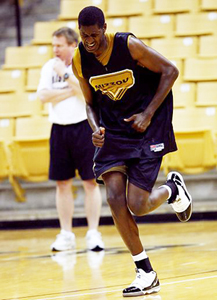- Offensive Techniques & Strategies
Training and Physical Conditioning
Superior conditioning does not just happen nor is it acquired quickly. It is the result of a well planned and executed program of exercise, rest, and diet. Training is exacting and the responsibility is heavy. What is done off the court is as important as what is done on it.
What to Discover or Recall:
Understand that to be successful, each player as well as the team collectively, must be possessed with the desire and determination to develop superior physical condition.
Comprehend that over exerting players at the beginning of the season is counter productive, and cuts down on player performance and learning.
Learn that physical workouts not only increase muscular, respiratory and cardiovascular capabilities, but also improves memory, problem solving and decision making.
Comprehend that early time and warm-up sets the tone for a successful practice.
Discover the importance of warming up and it's effects on player performance and health.
Realize that cooling down prevents serious injuries, and prepares players for the next day's practice or game.| Training | Conditioning | Warming Up | Early Time | Cooling Down |

Training Objectives and Demands
Because of the importance of physical condition and team morals to a successful season, willful violations of the training code cannot be tolerated or ignored. It is going to be up to "team pressure" to see that the code is adhered to and followed. Coaches are not policemen or detectives.
Any player who breaks training not only betrays themselves, their teammates, their coaches, their followers, and everything basketball stands for, they are also cheating their Maker that gave them the ability to be a success. If any player shows disloyalty to all these and does not feel guilty, they do not belong in the basketball world, let alone on your team.
Training Objectives
Training programs are designed to meet the following objectives:
-
To prepare to be in better condition than any team that you will play.
-
To allow you to sustain with ease and efficiency the pace required in game competition. Basketball players in an average game run approximately 3-3/4 miles at an average speed of 10 m.p.h. This is the toughest assignment in team sports.
To build a reserve for the extra efforts and overtime games.
To increase your individual performance. (Quickness, jumping, strength, and timing.)
-
To raise the level of individual players abilities and coordination. (They become sharper in fundamental skills of the game as the conditioning level increases.)
To help eliminate fatigue and cut down on injuries.
-
To increase proficiency in team play. (Conditioning allows a team to play harder and faster for longer periods of time.)
Physiological Objectives
To improve the efficiency of the cardio-respiratory system (aerobic capacity).
To delay fatigue and decrease recovery time (anaerobic capacity).
To increase general strength and muscle tone.
Training Demands
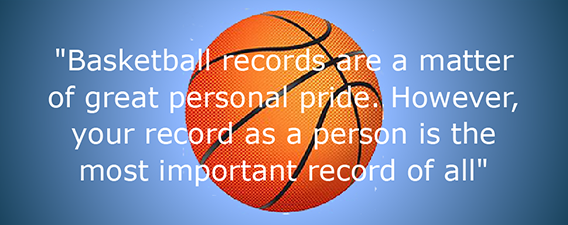
-
At least 8 regular hours of sleep each night. Proper rest is just as important to physical conditioning as exercise and diet. Training hours should be 11:00 p.m. on weekdays and 1:00 a.m. on the weekends. The night before a game the hours should be 10:30 p.m. You will be expected to be home by these hours and in bed shortly after.
-
Eat three balanced meals. Substitute fruit and fruit juices for desserts and snacks.
-
The use of alcoholic beverages and drug abuse cannot and will not be tolerated in any degree or form.
Players only have a few short years to play competitive basketball, so don't waste them. After your basketball career is over, if desired, you will still have 50 years to party and "Hoot with the owls.".
-
No smoking. Research has proven that smoking has a detrimental effect on the circulatory and respiratory systems, and thus athletic performance. Any player who smokes is untrue to himself, his teammates, and his coaches.
-
Be on time whenever time is involved. In the case of absence, notify a coach beforehand. If you are late to practice report before dressing.
-
Work to prepare for the best. Anytime you go onto the court you are expected to give nothing less than your best effort.
-
Absolutely no profanity or obscenity should be used on the court or in the locker room. An educated people can clearly express themselves without resorting to profanity.
-
Refrain from alibiing, griping, and criticizing others. These may lead to the lowering of morale which can only hurt the team. Some disagreements are to be expected; therefore if you disagree strongly with something or someone, air your views with the coaches, but be open minded and also respect their views.
-
Report all injuries and illness to the coach.


Physical Conditioning
To be successful, each player as well as the team collectively, must be possessed with the desire and determination to develop superior physical condition. Throughout the course of the season the team will be pushed and trained hard. However, it is going to be up to each individual to see that their maximum physical condition is achieved and maintained. Anything less is a violation of a trust.
| Physiological Benefits | Learning Benefits | Guidelines | Conditioning Drills |
Physiological Benefits of Conditioning
-
Increases oxygen consumption
Breath larger amounts of air at a slower rate.
Strengthens respiratory muscles increasing endurance and reducing resistance.
Increases utilization of oxygen. -
Increases the cardiac output
Heart pumps more blood per beat.
Reduces work load on the heart. -
Increases circulation
Improves general circulation.
Increases the number of red blood cells and amount of hemoglobin in the blood. -
Increases the ability to use energy sources
Use of energy sources is increased.
Replenishes energy stores at a faster rate (recovery).
Increases tolerance to high levels of lactic acid (fatigue). -
Increases muscle strength and tone
Reduces injuries with added alertness and strength.
Increases performance.
Prolongs the number of years of athletic performance.

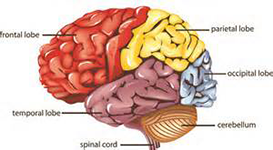
Brain Boosting Benefits of Cardio Exercise
There may be much more to being in shape than just gaining a physical advantage. Breaking a sweat on a regular basis can get your players into amazing shape, but new research has shown it can make them smarter too. Physical workouts will not only increase their muscular, respiratory and cardiovascular capabilities, it will also improve their smarts and productivity. Even a 30 minute workout pumps extra blood to the brain, delivering vital oxygen and nutrients it requires to perform at maximum efficiency. Cardiovascular workouts provide the brain with chemicals that enhance functions such as memory, problem solving and decision making. All which are critical to a successful basketball performance.
Working Out the Brain at the Same Time as Your Heart
According to clinical psychologists and memory researchers, cardiovascular health is more important than any other single factor in preserving and improving learning and memory. During exercise, all that extra blood bathes your brain cells with oxygen and glucose which they need to function. The more oxygen the brain gets, the better it performs.”
Muscles also send hormones to your brain. These hormones mix with a chemical, called brain-derived neurotrophoic factor or BDNF, which plays a role in brain cell growth, mood regulation and learning. John, Rately, associate clinical professor of psychiatry at Harvard Medical School, says, “BDNF is like fertilizer for the brain. Without it, our brains can’t take in new information or make new cells.” He goes on to state that exercise has another vital role in signaling the release of several key hormones that not only affects learning and attention, but also influences attention, perception and motivation. By elevating these hormones in the brain, it helps keeps us in focus, feeling better and releases tension.”
Importance of Practicing at Game Speed
Intensity of the workout does make a difference. A study in Neurobiology of Learning and Memory has found that people learned vocabulary words 20% faster after intense exercise than after low-intense exercising. Those who under take a more demanding exercise, experienced higher levels of BDNF, dopamine and epinephrine in their brains afterwards. Therefore, the more you challenge your body physically, the more the brain benefits. By being in great physical shape, it will not only allow your players to play harder and faster for longer periods of time, but will also enable them to think quicker and make better decisions.

Conditioning Guidelines
Have patience and do not rush your conditioning program. It is important to work up to strenuous exercise. Avoid straining and pushing players to the extent that they become over fatigued.
-
Overexertion is dangerous to players' health and defeats the conditioning program. Instead of feeling fit and vivacious, players will feel chronically tired and listless.
-
Symptom of overexertion and heat exhaustion are severe sweating, chest pains, severe breathlessness, dizziness, loss of muscle control and nausea.
CAUTION: If a player experiences any of these symptoms have them stop exercising immediately.

Basketball is a very long season. Too many coaches, similar to football, over emphasize conditioning at the start of season, and omit or neglect it as the season progresses.
Players' conditioning needs to be built up over a period of time. Maxim conditioning should be achieved for league play and playoffs.
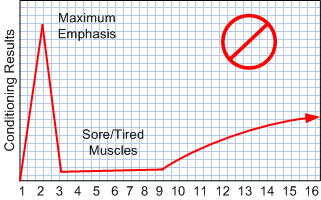
Over exerting players at the beginning of the practice season is counter productive, and will produce extreme soreness that will cut down on player performance and learning.

Conditioning Drills
Condition with the Ball!
Basketball is not cross country. Use fast break and full court drills for conditioning. Being able to execute at high speeds when tired is vital to a successful performance. Proven fast break and conditioning drills:
Don't expect players to condition at the same rate. Players condition at different rates. One size fits all does not apply to basketball. Do not expect your "Bigs" to condition at the same speed as the "Smalls." As a general rule, Smalls need to develop more physical strength while the Bigs need to work on improving their conditioning.

Early Time "ET"
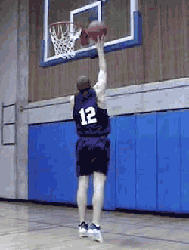
A Vital Part of Practice
| Early Time | Running Program | Shooting Program |
Early Time or "ET" is the time allotted before practice actually begins. This 20 to 30 minute period allows for players to arrive and prepare for practice. This is especially needed, when players have to travel to practice. Although, most coaches tell their players to use this time wisely and work on individual skills; in reality, most of this early time is spent socializing and getting caught up on the latest gossip. Who is dating who, etc.
The importance of Early Time cannot be over emphasized. It is the foundation of a successful workout. Early Time does not only prepare you physically; but more importantly, it puts you in the right frame of mind. With a proper use of early time you will be able to better concentrate, understand, and learn. As a result, you will be able to accomplish much more during the ensuing practice.
Be Early For "ET"
Players should allow themselves ample time to get to practice. There is nothing worse than arriving late for practice (or a game). Not properly warming up, will not only affect your performance and shooting, but it also increases your chance for injury. If for some unforeseen problem, you happen to arrive late for practice, do not expect to step on the floor and be at game speed. Use the first part of practice as your warm up. Handle the ball several times before shooting. Hopefully, you will be up to game speed both physically and mentally for the second half practice.
"ET" Starts With Putting On Your Shoes & Socks
Sitting on a chair or bench, make sure your socks do not have any wrinkles and lace up your shoes up properly. Be preventive and do not let the severe pain and agony of a sprained ankle teach you the lesson of the importance of putting your socks and shoes on correctly.
After lacing up your shoes, take a few minutes to sit on the edge of the chair or bench and warm up your hands and wrists by bouncing a ball. Dribble with each hand with head up. Cross over in front and behind your legs. Dribble one handed around a single leg, etc.
Have A Definite ET Routine
If your coach does not provide you with definite ET program, be sure to create one yourself. Here is one that has been very instrumental over the years in providing for very successful performances and individual skill improvement:
Basic Running Program
This running segment is intended to loosen you up, build strength and stamina, and prevent injury. All of these runs are done with both hands up near your shoulders. Go down and back before going to the next option. If desired you can run with a partner. When running with a partner, the spacing is such as when one partner gets to half court then the other one goes.
Jog. Easy jog with both hands up down the length of court. Pause and jog back to starting baseline.
Backward Running. Run to half court with hands up, turn and run backwards to baseline. Pause and repeat back to starting baseline.
Cross over Running. Facing side of court, use cross over steps (karaoke) to go the length of the court with hands up. Pause and facing same side of the court continue cross over steps back to starting baseline.
Vertical Jumping. Go length of floor with vertical jumps. Jump high with right knee coming up toward chest and right hand extending as high as possible. Land and repeat with left leg and left hand. Pause and continue back to starting baseline. Vertical jumping is similar to skipping except that you want jump as high as possible on each jump.
-
Hopping. Hop back and forth on one leg using the sideline, or any line running the length of the court. At half court, change legs and continue to hop back and forth over the line to the baseline. Pause and continue hopping back to starting baseline changing legs at half court. This is a skiers exercise use to build ankle strength.
-
Accelerations. Accelerate(sprint) to half court and then deaccelerate (jog) to the baseline. Pause and repeat back to starting baseline.
Defensive Slides. Run to half court, turn and defensive slide, changing directions, to the baseline. Pause and continue back to starting baseline.

Warming Up
The main purpose of a warm-up is to prepare for muscular activity and is not an exhausting activity to bring on fatigue. Therefore, players should not to expend themselves during the warm-up periods especially before a game.
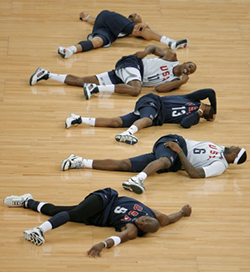
Starting a strenuous physical activity, such as basketball, without proper warm-up is not only detrimental to a player's health, but to their athletic performance as well. The warm-up period for basketball should be composed of some light running or shooting followed by a thorough stretching program. It should be of sufficient duration and intensity to adequately prepare oneself for the physical demands of the workout or game.
Physiological Benefits of Warm-Up
Increases blood and muscle temperatures of the entire body which improves athletic performance.
Increases the maximal oxygen intake.
Reduces the oxygen requirement for a given amount of work because hemoglobin gives up more oxygen at higher temperatures.
Increases lung circulation by decreasing the resistance to pulmonary blood flow.
-
Increases the speed of muscle contraction and relaxation by lowering the viscous within the muscle.
Increases metabolic rate.
Prevents muscle soreness and/or injury.
Static Stretching
Do not leave the responsibility of stretching up to the coach. If the team does not stretch as a group do it on your own.
NEVER stretch cold muscles, a proper stretching program actually start with some light running or shooting drills. At the minimum, jog a few laps around the gym before stretching. If desired, dribble a ball while jogging. However, be sure to have players dribble using both right and left hands. At the corners, switch hands by alternating front cross over, spin (reverse pivots), behind the back and between the legs techniques. In lieu of jogging, it is more beneficial to do a series of specifically related basketball running exercises going down the length of the court and back keeping hands up.
CAUTION: If players have any back, neck, bone or joint problems consult their doctor before undertaking a stretching program. Also, if a player encounter pain while stretching, it is a good indication that something is medically wrong and should not be ignored.
Stretching is performed by slowly moving a joint to its complete range of motion. A gentle pulling should be felt in the desired muscle. Hold this position for 15 to 20 seconds, and then extend just a little bit further for a few more seconds. Do not stretch to the point of pain or bounce since this may cause injury to the muscle. Normally, stretch each muscle (group) three times with each subsequent stretch progressively done with increased flexibility and range.
In performing the various stretching exercise, it is important to warm-up the entire body. Alternate between agonist and antagonist muscle groups (quadriceps and hamstrings / biceps and triceps) alternating right and left sides. Do not hold your breath. Breathe slowly and relax. Relaxing is a very important element in stretching. Stretching is not a rushed or social event. Free up your mind. Visualize proper form and technique.
Flexibility
Flexibility is not only vital to athletic performance, it also helps prevent injuries. However, flexibility will only increase with work over a long period of time. There are no short cuts. Muscle elasticity and range of motion decreases with age. Bending or flexing becomes more limited and the muscles take longer to stretch out. This is why stretching regularly, as part of a routine, is very important, especially the older you get. Failure to stretch properly will only increase the chance of injury that can lead to missing a game or even the entire season.
When you exercise, muscles shorten and tighten. Therefore, stretching after practice should be an integral part of your training program.
Basic Shooting Program
Although these shooting drills may seem simple and redundant, they are vital to becoming a good shooter. They also should be done any time you practice on your own.
-
Backboard Tipping. Tip the ball one handed off the backboard (or wall) 10 consecutive times right handed, and then tip 10 consecutive times left handed. You may try to tip the tenth repetition into the basket. Be off the ground for each tip and learn to control the ball with your fingertips. (Repeat three times for a total 60 tips).
Alternate Lay-up Drill (Mikan). Face the basket, take a step with your left foot toward the right side of the basket and shoot a right hand lay-up off the backboard. Rebound the ball and take a step with your right foot to the left side of the basket and shoot a left handed lay-up. Keep the ball high and do not ever allow the ball to come below your out stretched arms. Continue until you make 12 shots. (Repeat 3 times for a total of 36 shots).
Rebound Shot with bounce. On right side of the basket, toss the ball high off backboard. Jump up and rebound it, keeping arms straight. Without bending arms quickly bounce off both feet and shot the ball into the basket. Quickness is important on this shot. Repeat on left side of basket, shooting with left hand. Continue alternating right side and left side until you make 12 shots. (Repeat 3 times for a total of 36 shots).
Dribble Shoot. From the right elbow (corner of the free throw line) take one dribble to the basket and shoot a right handed over hand lay-up off the glass. Rebound the ball and take two dribbles out to the opposite (left) elbow. Pivot without stopping the dribble and take one dribble to the basket shooting a left handed over hand lay-up. Go hard to the basket and keep your head up and eyes on target. Dribble with your right hand on right side of basket and with left hand on left side of basket. Continue until you make 12 shots. (Repeat 3 times for a total of 36 shots).
Individual Shooting. This is not a free shoot. Concentrate on the areas and types of shots that you will be taking during an actual game. Be sure to include "Bank Shots" and Free Throws. In fact, never start a practice or a game without taking some Bank Shots and Free Throws.
NOTE: If time is a factor cut down to 2 sets rather than hurry. Remember you can practice bad habits as well as good habits.

Importance of Cooling Down
The importance of cooling down after exercising cannot be over emphasized. Not only does it prevent serious health problems and injuries, but also, prepares players for the next day's practice or game. After exercising, taper off gradually. A sudden stop can cause dizziness, fainting, cramps, or even more serious consequences. Players should wait until they have stopped sweating before showering.
Heart Rate Recovery
One of the most important benefits of conditioning is the ability for the heart to recover during exercise. Players in top physical condition will recover much faster than players out of shape. This is a real advantage in athletic competition.
To determine your heart rate: take carotid pulse (neck) for 10 seconds and multiply by 6. Five minutes after exercising, your heart rate should be below 120, and ten minutes after exercising it should be below 100.
If 5 minutes after exercising your heart rate is above 120: the exercise is too severe for a person in your condition. Train at a slower rate for a longer period of time.
If 10 minutes after exercising, if your heart rate is above 100 let up on your exercise program.
CAUTION: Always cool down after exercising. Players should never go to the showers until their heart rate is below 100.
Respiration Rate Recovery
Normal respiration rate is 12 to 16 times per minute. If you respiration is above 16 times per minute or you are still short of breath after ten minutes, the exercise is too strenuous.
End of Practice Free Throw Shooting
The cooling down period is an excellent time to practice free throw shooting. Successfully shooting free throws, when tired, is vital to end of game situations.
Free Throw Drill 1: Make two consecutive free throws at a basket and then rotate clockwise to the next basket. Rotations continue until player has made two consecutive free throws at each basket. This combines the free throw shooting and cooling down walking. It will also provide players with the mental confidence in their ability to make two consecutive free throws in a game when tired.
Free Throw Drill 2: Progressive free throw shooting rotating baskets. Divide team into two groups with each group starting at opposite baskets. Players must make two free throws in a row at first basket then rotates to next basket. At the second basket, they must make four consecutive free throws prior to rotating to the third basket. Make six free throws in a row at third basket. Make ten consecutive free throws at the fourth and final basket. When shooting, when the shooter misses they go to end of the line. Once a player in a group has made 10 consecutive free throws, the remaining players divide up at the baskets and make 10 in a row. Reward the two winners.
Basic Stretching
The cooling down period should conclude with various stretching exercises. This is especially true after a strenuous work out. By stretching after practice, it actually prepares players for the next day's workout by lessening the tightness and stiffness build up that would otherwise occur. When stretching be sure to avoid any bouncing.
This is also an excellent time to review and emphasize what was covered in the practice, answer any questions players may have, and to inform players as to what to expect in the next practice.
Return to Practice Guidelines - Click Here
Return to Coaching Strategies - Click Here
Return to HoopTactics - Click Here>
© 2026 HoopTactics All Rights Reserved.

